A product of the prideful city of San Jose, Orly Locquiao is widely considered, one of, if not the most influential Polynesian tattoo artist in the Bay Area. One of the nicest and most humble people you’ll meet, the Filipino ink maestro is never one to take himself too seriously, but when it comes to tattoos, his game face changes as soon as the switch turns on. Founding his studio, Humble Beginnings, in 2002 and clothing line, Cukui, in 2009, he’s managed to balance two highly time-consuming businesses, including a retail store in San Jose and a second flagship location on San Francisco’s storied Haight Street later this year.
I’ve known Orly for a few years and our conversations don’t really ever focus on what he does professionally, so this last trip back home, I stopped by his shop to talk ink and get a little schooling for myself on a culture I’m not all too familiar with but have always been intrigued by. Amongst other things, we spoke about his recent work with San Francisco 49ers quarterback Colin Kaepernick, what pushes his buttons and how he’s managed to translate his artistic talents into an unlikely retirement plan.
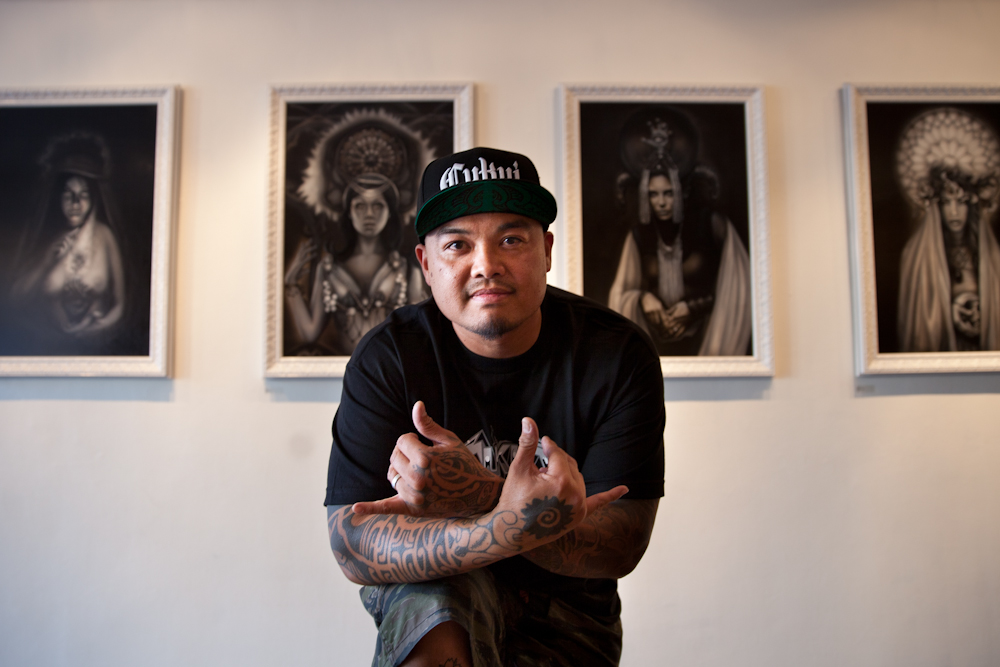
Humble Beginnings founder Orly Locquiao
Alright dude, what’s the weirdest customer request you’ve ever had?
This old man – the first couple months I opened my first shop – comes in, about 65 years old, he wants to get a tattoo. He says he wants to get a Tasmanian devil. And I say, “Where do you want to get it?” and he says, “I want to get it in my pubic area.” And I’m like, “Damn!” but I can’t say no because I just opened the shop, so I need all the money I can get. And by this time it was 7 o’clock at night and I did one tattoo for $60 and I’m like, “Dude I’ve got to do another tattoo or this day is going to be busted.” So he shows me this design of this Tasmanian devil that’s about an inch tall and he wants it on his pubic area. So I was like, you know what? I’m just going to do it; I don’t even care. So I give him a razor and go, “Where do you want it?” He pulls down his pants and he goes, “I want it right here.” And I look at his fucking pants, I look at the area, and he has a Tasmanian devil on the other side of his pubic area. So I’m like, “You want it on the other side?” He goes, “Yeah, my girlfriend says it would look nice; it would look cute if I had another one matching.” I was like, “Are you fucking serious?”
So I go, I give him a razor and tell him to go in the bathroom and shave that area. So then I tell him, “Just shave it, I don’t want to shave it.” So I’m drawing the Tasmanian devil, which is, mind you, an inch tall. So I draw it out, make the stencil, he comes back with a razor in his hand, and then he goes, “I don’t know what to do with this.” So I’m like, “Ah! You want me to shave it too?!” [laughs] So I go, “Alright, fuck it, whatever.” I shave it, I put the stencil on his pubic area – this is a 65-year-old man – I put the stencil on his pubic area above his piener, and I line it up with the other one because that’s how he wanted it; lined up with the other one like friends. I think that was the fastest tattoo I ever did in my life. [laughs]. I probably tattooed that thing in five minutes. I tattooed it; outlined it, colored it, shaded it, everything in five minutes. I got my money and that was it, that was the last time I ever heard from him.
That was the weirdest tattoo. There were a couple of other weird ones but that was the weirdest one just because… ah, that was a horrible experience. I think shaving the pubes was the worst. Shaving the pubes of a 65-year-old man when his pubes are fucking hard and crusty. That was bad; that was the worst.
Man, I don’t know what to say. [laughs] I remember you mentioned before that you used to work at Great America, how long did you do that for and how did that help you later on? Is there anything that you did there that you didn’t realize was beneficial in your career until years later?
Airbrushing. I was 16 and got hired as an independent contractor. So that was my first job. I didn’t know [then], but that was my initial introduction into being an entrepreneur. I had to do my own taxes, I had to work to earn my money that day. So it’s almost the same thing as tattooing. If I did 20 T-shirts that day then that’s how much I made in commission and stuff. I still made my five dollars an hour or whatever the hell it was back then, but at a certain point if you go over, like, 20 shirts, that’s when you start making the real commission. So that’s what we would strive for; hitting that mark. But that introduced me to being my own boss. Like, “Alright, I have an airbrush, all I need now is a compressor, an electrical outlet, and some paint and I can do this at the swap meet, I can do it at the flea market, I could go paint somebody’s car,” so that was the introduction to being an entrepreneur.
What type of stuff did you airbrush?
I used to do all that “Lucy loves Leonard” type of stuff. “1994, always and forever.” At that time it was funny because there was this thing called Cherry Creek Flash, which was pretty much the staple and it was fucking weird shit like wizards and dragons and pit bulls, bull dogs. So I was doing a lot of that, all that kind of weird stuff.
Did your parents ever question what you wanted to do with yourself as far as a career goes?
Yeah, always. They always questioned, always wanted me to be a nurse – in Filipino culture they want you to be a nurse or an engineer and they wanted me to be that or something other than an artist because they didn’t fully understand. No old school parent understands that nowadays you can make money off art if you really hustle. But after years of tattooing they finally accepted it.
But they were always pretty good. They didn’t really understand, but when I wanted to be an entrepreneur and open my own shop, that’s when they really had my back because I was still living with them and I had to save up money and just try to make the dream come alive.
Where are you originally from?
I’m originally from the Philippines. I came here when I was two. My dad was in the Navy and eventually moved us to the states in ’78. I was raised in San Jose and then moved away to Chicago for art school.
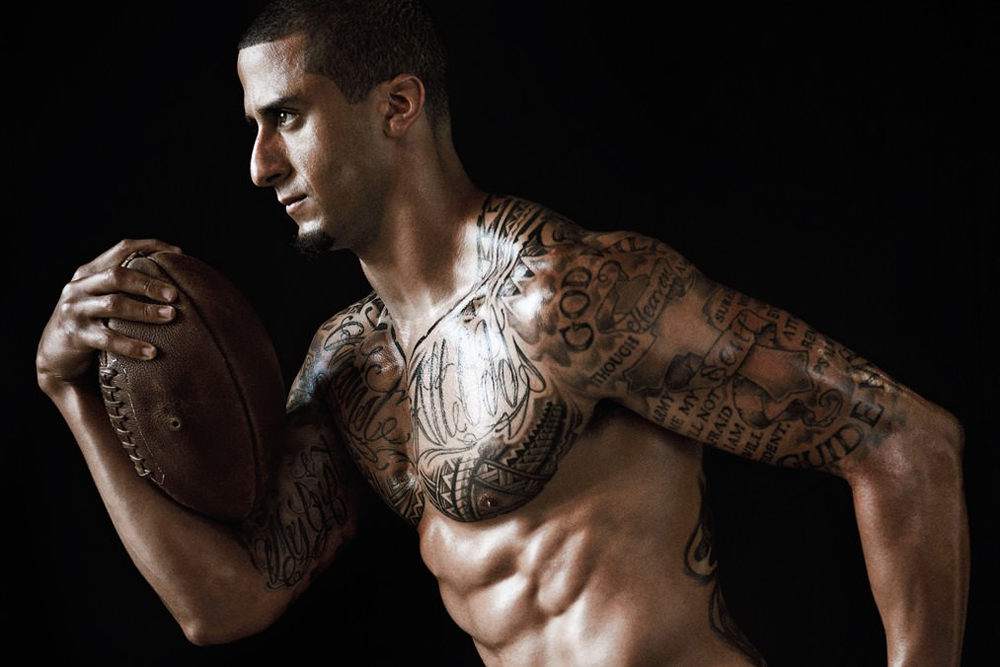
Orly’s tribal work on Colin Kaepernick featured within the pages of ESPN The Magazine
When did you open your tattoo studio, Humble Beginnings?
2002. I think it was winter of 2002 when the first shop opened. And that was kind of near downtown San Jose.
How long was it before you gained some notoriety in the city?
It was hard because a lot of people didn’t understand me opening a “Polynesian South Pacific Tribal Tattoo Shop.” That was the main focus of the shop. I could tattoo almost anything else but I wanted the main focus to be that: to be rooted in culture of South Pacific tattooing. It took a little while but we’ve been open for 11 years now, so probably three or four years for people to catch on. People were catching on but it wasn’t as big as it is now. When I moved back [to San Jose], I was one of the only ones here in the Bay Area, there were a couple older folks but just strictly trying to open a shop, I think I was one of the only ones.
You obviously have a pretty big clientele. You did work with Colin Kaepernick recently – you’ve done work with other athletes as well – how has that helped you out, or helped the shop out? Doing work for guys like that and seeing how newsworthy that stuff has been, especially in Kaepernick’s case where it became a huge topic in the sports world for weeks?
That was huge for the brand [Cukui]. Working with Kaepernick, I think, was the biggest push for the brand but it helped with tattooing as well. I was always busy as it was, but that just pushed it over the edge a little bit. It’s good because a lot of people recognize our brand, especially when he wears it. We’re a small company, so it helped a lot for him to wear it in interviews and stuff like that.
Tattoos have obviously become a bit more socially acceptable, but as of late, for me at least, I’ve noticed an influx of young kids replicating athlete’s looks without much of a regard for their own appearance and how that can lead to career opportunities, or lack thereof.
When I first started tattooing, there were only a few [tattooed] guys, like Dennis Rodman, but now tattooing is so accepted and it’s kind of good and bad. And that’s because you got [professional athletes] that are fully tattooed but youngsters don’t understand that those guys are all established. They have their profession, they make their living, and they make a ton of money so they can do whatever the hell they want. They can tattoo their hands to the top of their head because they’re all established.
I don’t want to talk smack about a lot of the kids that are getting tattoos now – but don’t just automatically get your forearms done. Start from inward out. This is where it gets a little touchy because a lot of youngsters fucking get all pissed off because I’m at that middle age where I’m not the older cat but I’m not young anymore. So when I was starting to tattoo, I had to cover everything up, everything was sleeves and up: back, chest, thighs, and then you get everything else after.
I watch ESPN’s First Take every morning, and one of the pundits on the show, Stephen A. Smith, is constantly talking about a lack of focus on image amongst today’s youth. Example: How are you going to get a job if you have tattoos up to your neck? Everything is about perception, about image as a youth. What’s your take on that?
You got to earn your stripes, get everything else done before you start getting the opposite. You get your neck, your forearms, and your legs done. And then when you wear shorts and a shirt and it looks like you got a full body suit on. [laughs] Traditionally it was the opposite. Back in Japan they couldn’t show anything, so they worked the entire chest, all the back, and the stomach area. The areas that you could hide. You didn’t want to show that. Now it’s so accepted that you could show everything.
This kid came into the shop the other day to get his first tattoo. Just turned 18. His dad brought him into the shop and I asked him what he wanted to get. He said, “I wanna get my forearm done.” I said, “What other tattoos do you have?” he said, “This is my first tattoo.” I said, “You want to get a big tattoo on your forearm and you don’t have anything else? So what do you do?” He said, “Oh, this is my first year of college.” “So why don’t you just start off with your upper arm and then go down? Or your leg because then you can wear pants and hide it.” “No, I want to show it off.” That was the word. “I want to show it off.”
So it just pissed me off, but at the same time, I can’t say no because this is work towards feeding my family. I mean, I could say no, but at the same time it was like, man, this is 2014 and people are going to do what they want. It’s not like 1995 where if you had a tattoo on your forearm, you’re on a different level than everybody else.
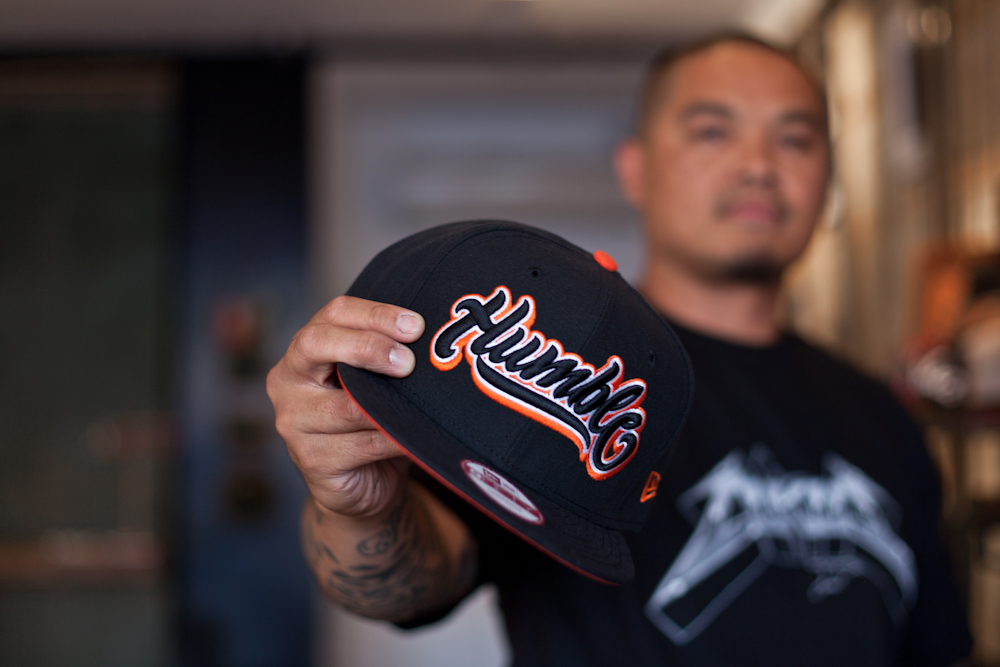
One of Cukui’s latest snapbacks
Your work inspires your clients to want you to be the one gracing their bodies with your art, but have you ever found inspiration from your clients?
There was a point when I moved back here from Hawaii and I was tattooing a lot of Mexican people, a lot of black people. Just a lot of different ethnicities. And they wanted to mix their cultures. Say it was African, say it was Native American – mix that with Polynesian. So they would bring me their pottery or they would bring me pictures and stuff and that was a huge inspiration because that flipped the whole script on everything “traditional” because it was, “I want this Native American pattern but I want Polynesian all around it. I want a fusion of both.” That was a huge inspiration because that’s when it opened my eyes up to doing Aztec stuff, Mayan stuff, African stuff. I started getting more into that. So I was really studying to flip things a little bit more, because people would then look at stuff and be like, “Oh, this isn’t a Polynesian pattern… Oh no, this is a–”
You’re almost fusing traditional with contemporary.
Yeah, I gotta do that because you have to always keep it moving, always have to be in the forefront of all that.
Do you do all of your tribal work freehand?
I do it all freehand, yeah. Which works a lot easier. I don’t know, I guess that’s a pet peeve too, when people just want me to do a full drawing but they don’t understand. It’s funny because I’ll draw it on paper and then I’ll draw it on their arm and they’re all like, “Oh, it’s perfect but it’s not even the same thing that was on paper.”
What’s a misconception that you feel people have about tattoos now? More so than before?
That whoever has tattoos is a thug, that they’re a bad person, that they’re a thief, that they have a negative persona.
Do you get that a lot yourself?
Yeah, I still get it nowadays. Especially me because I have them all the way to my fingertips. I think not so much if you just have sporadic tattoos here and there but if you’re fully tattooed all the way to the neck, that gets a little bit crazy. But people are always going to have that perception. I think that’s always going to be the perception of tattoos all around the world. And it’s mostly older folks, the younger generation they more admire the tattoo opposed to downgrading it. But if you fit the part – if you look super thugged out and you’re hella tattooed then of course you fit that part. But if you’re dressed up cool, you’re dressed up nice, and you have tattoos then it’s a whole different perception. So you gotta fit that part almost, whatever part you are in this society I guess.
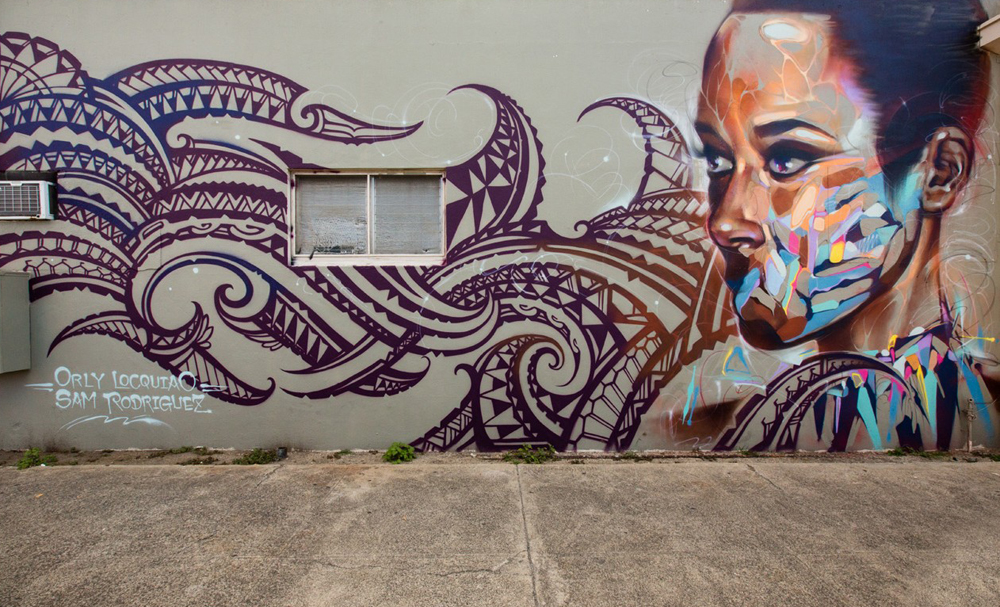
Orly showing off his skills with the spray can alongside Samuel Rodriguez
What would you say was a tougher task, starting a brand or opening your first tattoo shop? Which do you see as the long-term investment?
Starting a T-shirt brand, I think, was even harder [than tattooing] because you need money to fund the line and the people that work for you and all that stuff. That was the hardest thing. People always ask, how do you do it? You really just have to sacrifice a lot time and money, unless you come from money, then you already have that part taken care of, but most don’t have that luxury.
I had to push all of this (Cukui) through my tattooing. A lot of my tattoo money pushed the brand and that was the only way I could do it. I was fortunate enough to have a job that could fund it because I was looking at this as more of a retirement plan. I knew I couldn’t tattoo. My peers were telling me, “Dude, you’re not going to tattoo forever, your hands are going to go out, your arms are going to go out, your eyes are gonna get all fucked up. What’s your retirement plan?” I’m lucky enough to have older peers telling me, “I don’t have a retirement plan, I never saved up” – and a lot of tattoo artists don’t because you make that money and then you spend it right away. It’s such an easy way to make money, but most people don’t know how to save or invest with it.
So instead of saving why not put it to somewhere and take a risk? That next risk for Cukui is opening up our Haight Street store and that’s a big ass risk. But at the same time, like one of my peers said, besides the obvious “no risk, no reward” – “If you don’t risk it while you’re young, then don’t risk it at all. It’s better to risk it while you’re young and lose your money now as opposed to losing it when you’re old and can’t work anymore.” [laughs] Then you’re screwed and you just burned all that money.
Our formula was always to have a good crew. Out of everything, besides producing good product and having a brand that’s always trying to push for inspiring designs – it’s a crew, a solid crew. Because if you don’t have that then you’ll have people thieving, stealing, talking smack behind your back, and not even believing in the brand. They have to believe in the brand. That’s the main thing. If you want to start a clothing line, I say do it because it’s rewarding. You just gotta be patient, it doesn’t happen overnight. For some people it does though. [laughs]
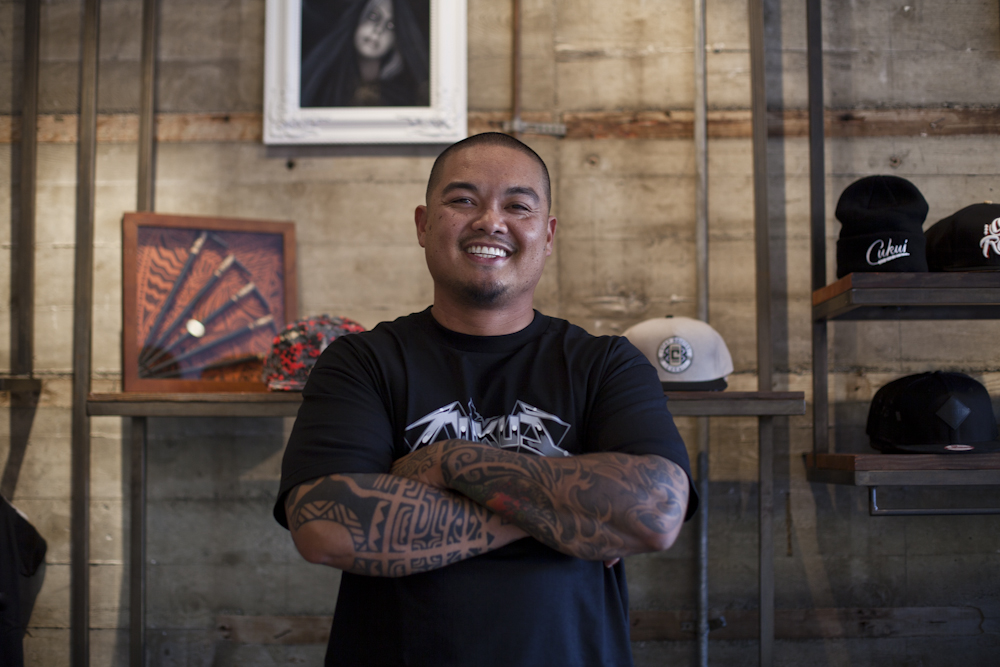
::
::
More of Orly’s work can be found at Humblebeginningstattoo.com and through his Instagram account, @orlycukui.

